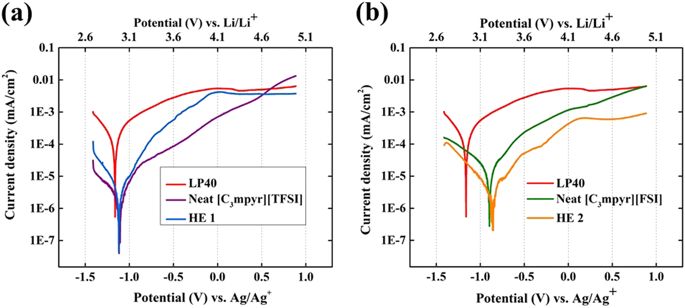npj Materials Degradation ( IF 6.6 ) Pub Date : 2018-03-29 , DOI: 10.1038/s41529-018-0033-6 Sowmiya Theivaprakasam , Gaetan Girard , Patrick Howlett , Maria Forsyth , Sagar Mitra , Douglas MacFarlane

|
The compatibility of current collectors with the electrolyte plays a major role in the overall performance of lithium batteries, critical to obtain high storage capacity as well as excellent capacity retention. In lithium-ion batteries, in particular with cathodes that operate at high voltage such as lithium nickel cobalt manganese oxide, the cathodic current collector is aluminium and it is subjected to high oxidation potentials (>4 V vs. Li/Li+). As a result, the composition of the electrolyte needs to be carefully designed in order to stabilise the battery performance as well as to protect the current collectors against corrosion. This study examines the role of a hybrid electrolyte composed of an ionic liquid (N-methyl-N-propyl pyrrolidinium bis(trifluoromethanesulfonyl)imide or N-methyl-N-propyl pyrrolidinium bis(fluorosulfonyl)imide) and a conventional electrolyte mixture (LiPF6 salt and alkyl carbonate solvents) with correlation to their electrochemical behaviour and corrosion inhibition efficiency. The hybrid electrolyte was tested against battery grade aluminium current collectors electrochemically in a three-electrode cell configuration and the treated aluminium surface was characterised by SEM/EDXS, optical profilometry, FTIR, and XPS analysis. Based on the experimental results, the hybrid electrolytes allow an effective and improved passivation of aluminium and lower the extent of aluminium dissolution in comparison with the conventional lithium battery electrolytes and the neat ionic liquids at high anodic potentials (4.7 V vs. Li/Li+). The mechanism of passivation behaviour is also further investigated. These observations provide a potential direction for developing improved hybrid electrolytes, based on ionic liquids, for higher energy density devices.
中文翻译:

铝集电器在离子液体碳酸烷基酯(混合)电解质中的钝化行为
集电器与电解质的相容性在锂电池的整体性能中起着重要作用,这对于获得高存储容量以及出色的容量保持能力至关重要。在锂离子电池中,特别是具有在高电压下运行的阴极(例如锂镍钴锰锰合金)中,阴极集流体是铝,并且经受高氧化电势(> 4 V vs. Li / Li +)。结果,需要仔细设计电解质的组成,以稳定电池性能以及保护集电器不受腐蚀。本研究考察了由离子液体(N-甲基-N-丙基吡咯烷鎓双(三氟甲磺酰基)酰亚胺或N-甲基-N-丙基吡咯烷鎓双(氟磺酰基)酰亚胺)和常规电解质混合物(LiPF 6盐和碳酸烷基酯溶剂)与其电化学行为和缓蚀效率相关。在三电极电池配置中针对电池级铝集电器对混合电解质进行了电化学测试,并通过SEM / EDXS,光学轮廓仪,FTIR和XPS分析对经过处理的铝表面进行了表征。根据实验结果,与常规锂电池电解质和高阳极电位(4.7 V vs. Li / Li +)。还进一步研究了钝化行为的机理。这些观察结果为开发基于离子液体的,用于更高能量密度设备的混合电解质提供了潜在的方向。











































 京公网安备 11010802027423号
京公网安备 11010802027423号